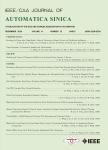版权所有:内蒙古大学图书馆 技术提供:维普资讯• 智图
内蒙古自治区呼和浩特市赛罕区大学西街235号 邮编: 010021

作者机构:the School of Control Science and Engineering Shandong University IEEE the School of Electronic and Electrical Engineering University of Leeds the Qingdao University of Science and Technology the Department of Automation Shanghai Jiao Tong University the Key Laboratory of System Control and Information Processing Ministry of Education of China
出 版 物:《IEEE/CAA Journal of Automatica Sinica》 (自动化学报(英文版))
年 卷 期:2025年第12卷第3期
页 面:596-605页
核心收录:
学科分类:0711[理学-系统科学] 07[理学] 08[工学] 081101[工学-控制理论与控制工程] 0811[工学-控制科学与工程] 071102[理学-系统分析与集成] 081103[工学-系统工程]
基 金:supported by the National Nature Science Foundation of China (62073194) the Natural Science Foundation of Shandong Province of China (ZR2023MF028) the Taishan Scholars Program of Shandong Province (tsqn202312008)
主 题:Event-triggered mechanism heating, ventilation, and air conditioning (HVAC) control probabilistic reachable set stochastic model predictive control
摘 要:This paper proposes an event-triggered stochastic model predictive control for discrete-time linear time-invariant(LTI) systems under additive stochastic disturbances. It first constructs a probabilistic invariant set and a probabilistic reachable set based on the priori knowledge of system *** with enhanced robust tubes, the chance constraints are then formulated into a deterministic form. To alleviate the online computational burden, a novel event-triggered stochastic model predictive control is developed, where the triggering condition is designed based on the past and future optimal trajectory tracking errors in order to achieve a good trade-off between system resource utilization and control performance. Two triggering parameters σ and γ are used to adjust the frequency of solving the optimization problem. The probabilistic feasibility and stability of the system under the event-triggered mechanism are also examined. Finally, numerical studies on the control of a heating, ventilation, and air conditioning(HVAC) system confirm the efficacy of the proposed control.